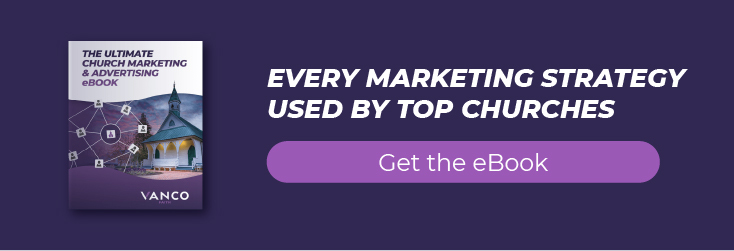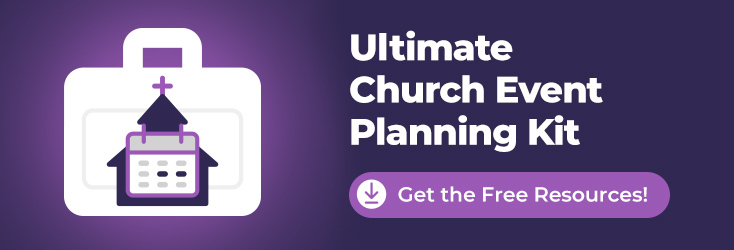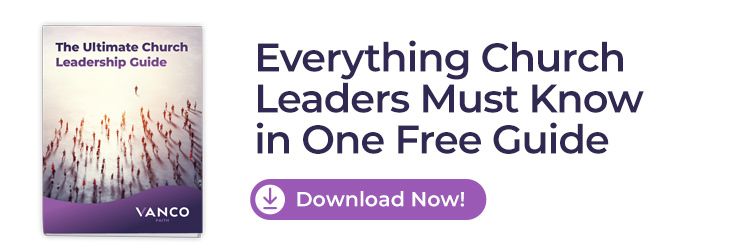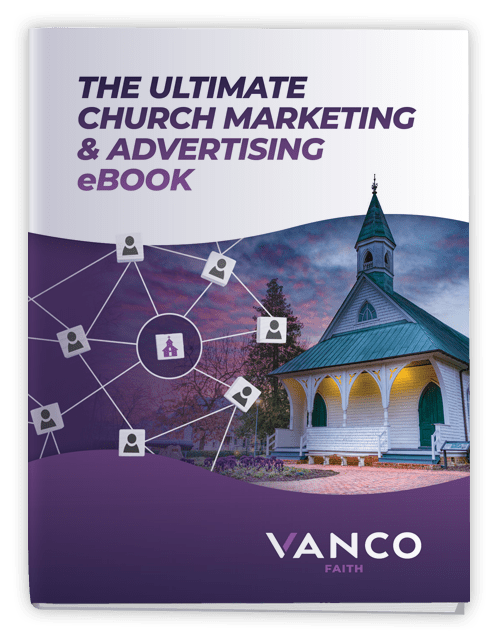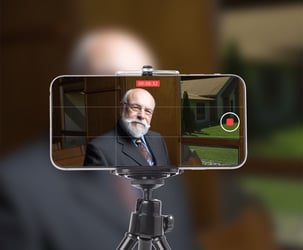 Are Facebook Ads for churches effective? Is using Facebook for churches still a good idea even if you're not paying for ads?
Are Facebook Ads for churches effective? Is using Facebook for churches still a good idea even if you're not paying for ads?
The popularity of Facebook within faith communities suggests the answer to both questions is yes. Facebook continues to dominate the social media universe, with about 1.84 billion people visiting the platform daily. As of 2021, the social network site has 2.80 billion active monthly users.
Given its mind-boggling popularity, it’s no wonder the number of churches using Facebook continues to rise. Currently, almost 85 percent of churches are active on social networking sites.
But how can you use Facebook to promote your church? Read on to learn how to use Facebook for churches. You’ll see all the methods ministries across the globe have used to boost giving, grow church membership and engage members.
Table of Contents
The Free Version of Facebook for Churches
Churches can pay for Facebook Ads, but most churches using Facebook focus on an organic strategy to get started. Focusing on organic first helps them get acquainted with the nuances of promoting a church on Facebook. This way they don't need to pay Facebook as they learn. After running organic promotions for your church's Facebook for a while, you'll have some of the prerequisite knowledge needed to build strong paid church advertising campaigns.
When we say organic, we mean these churches don't pay to promote their content on Facebook.
Churches using Facebook for free will be able to engage members and even reach those outside their congregation. However, there are drawbacks.
Facebook doesn’t let your posts reach all your members. And, each post you make has an even smaller chance of reaching people outside your community.
That’s why a growing number of churches interested in growth eventually use Facebook Ads for their churches.
Build a Facebook Page for Your Church
If you haven’t done so already, it’s time to create a church Facebook page. Sure, your website may help people learn more about you, but a Facebook page is more effective when it comes to developing an active online community.
Your church Facebook page isn’t just a platform for your existing church group to engage. It’s also a wonderful opportunity for outreach. As church members like and share your updates and photos, this content shows up in their personal newsfeeds. Their friends who aren’t members of your church Facebook page get to view that content, widening your reach.
Your church Facebook page is also an excellent place to disseminate information to members. For instance, after writing church announcements, you can opt to post them to increase visibility.
Create Events and Invite Friends
Another way churches use Facebook is to create events on the platform and invite people to join. You can use Facebook Ads for church event promotion, but you can also promote them organically. If you're first starting out, try promoting them organically first.
An event can help create momentum among users and enhance their attendance and involvement. Members of your church’s Facebook page can also invite their friends to the event.
Note that you don’t need an elaborate event to get started. Even posting the week’s sermon and creating an event around the topic is enough to create a buzz and attract new congregants.
Because you can create events directly on the platform, it’s easy to promote church events on Facebook. You can expand the reach of your Facebook event to grow attendance by encouraging members to share your event with their friends and family.
Encourage Church Members to Regularly “Check-In” on Facebook
Another great use of Facebook for churches is the check-in feature. Remind church members to check in on their Facebook account whenever they arrive at the church. When they do, the information immediately appears in their timelines, and their friends can see it.
The idea here is to get more people to notice your church. If someone on Facebook sees that a few of their friends checked into your church, they may also be interested in doing so. That’s because they realize there’s something interesting going on in your church.
Invite Guests to Join Your Church Facebook Group
Whenever you receive guests at your church, do your best to make them feel welcome and part of your family. One excellent use of Facebook for churches that will accomplish this goal is group invitations.
Use group invitations to notify newcomers of your Facebook group and invite them to join.
Inviting guests to join your church social media accounts shows newcomers that you see them as more than church visitors. It shows that you want to become friends with them. This positive gesture can go a long way in helping you create and nurture many new friendships.
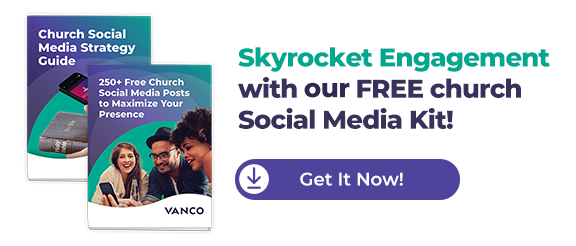
Connect with Other Ministries on Facebook
Networking is another great use of Facebook for churches. As we pointed out earlier, the vast majority of churches in America regularly use Facebook. The widespread use of this platform gives you the opportunity to connect with ministries that have a church mission and vision similar to yours.
You can connect with other churches by liking their Facebook page. From that point, you’ll be able to share some of their status updates on your church’s Facebook wall. Such material can prove highly valuable for people who visit your Facebook wall.
Besides, when you connect with other ministries on Facebook, chances are you’ll catch their attention and arouse their interest in your ministry as well. It could very well be the beginning of a mutually beneficial relationship with other ministries.
Connecting with other ministries through Facebook also helps churches share information on what works best for promoting their church.
This is especially helpful for ministries using Facebook Ads for church missions. Before spending money on ads, you can ask them what worked well for their church and what didn't.
If your church is part of a larger denomination, try to forge relationships with churches across the country to see how ministries like yours promote themselves on Facebook.
Share Livestream Videos of Church Services
One of the best ways to use Facebook for churches involves sharing livestream videos of church services. You can even livestream worship on Facebook through Facebook Live. Streaming is a great way to connect to a larger audience. It allows potential visitors to see what your church is about before they enter the doors for the first time. And, it can help those who wish to join your church but are unable to make it every week due to distance or health concerns.
Check out our Facebook Live Stream Guide if you’re looking to master streaming. It explains...
- The benefits of using Facebook Live.
- How to get started with Facebook Live.
- The necessary equipment for Facebook Live.
- How to livestream to Facebook (phone & computer).
- How to livestream to Facebook using a camera & software.
- Facebook Live optimization.
- And much more!
You'll want to spend some time learning about Facebook streaming, as some of the most successful content churches promote are recordings and livestreams. Livestreams and recordings are especially important when it comes to using Facebook Ads for church growth.
Videos of worship services are a great way to show those outside your community how your church fulfills its missions and how it can help them nurture their faith. You can also post church video announcements on your Facebook page to promote upcoming services, fundraisers and events.
Some churches even repurpose their sermon's audio recordings to create podcasts. These church podcasts are a great way to draw new people into your church, especially when you promote them on your church's Facebook page.
Don't Forget About Instagram
You might not know this, but Instagram is a part of Facebook. In 2012, Facebook purchased Instagram. That purchase has paid off for them as this platform is very popular with Gen Z and Millennials.
If your church is seeking to increase your number of younger members, you’ll want to include Instagram in your strategy. You can repurpose some of your Facebook posts and adapt them to Instagram to streamline your work. And, because Facebook owns Instagram, you can create ads that work for both accounts from one place, Facebook Ads Manager.
If you’re looking to create your church’s Instagram account, check out these two free guides that will help you get started.
Give Your Facebook Page a Human Touch
The last tip on how to promote your church on Facebook is to ensure your page feels human to visitors. You can accomplish this by sharing pictures and video recordings of what goes on behind the scenes at your church. Another great idea is to organize regular Q&A sessions with the church staff.
Encourage the administrator of your church’s Facebook page to always add a personal touch when responding to comments. For instance, they could add their first name or initials at the end of their comments. That makes it easier for people to know that there’s a person behind your church Facebook page, not a robot.
Facebook Ads for ChurchesFacebook might has a lot of users. With so many active users, it is a valuable tool for evangelizing. But, there’s one problem. Over the years, Facebook has limited the organic reach for organizations.
Even when churches using Facebook try to connect with their followers, it’s tough for them to reach their newsfeeds. The reason for all this is Facebook wants to make money with their ads. And it's hard to blame them, especially when their competitors, such Google Ads, have also prioritized paid ads over organic results.
Facebook Ads for churches solves the issue of reach for ministries.
There’s plenty of debate as to whether or not ministries should be using Facebook Ads for churches. Ultimately, it is up to each church to decide what’s right for their congregation.
This guide will focus on how to maximize Facebook Ads for churches in a way that doesn’t cost a ton of money for each intended result.
Facebook Ads for Churches - The Plan
Advertising is an amazing use of Facebook for churches because it provides results. However, if you’re not careful, it will end up burning through church resources without offering results. Before embarking on your church’s Facebook ad journey, build a plan for setup and management.
Your pastor or your church secretary probably don’t have a lot of time for setting up the Facebook Ads for your church. That’s why it is best to get help from a volunteer.
Find a Volunteer
Getting a volunteer to help you with Facebook Ads for church isn’t as hard as you might imagine. If your church has a strong youth contingent, especially those within college working towards business degrees, you can help them gain valuable experience.
Facebook has become ubiquitous in marketing, and they’ll need the experience of running an account if they’re to succeed in their careers. And, because few business programs cover Facebook Ads setup as a part of their curriculum, you’ll be providing these volunteers with an opportunity their tuition doesn’t offer.
Place a callout on your church bulletin for a volunteer along with a link to the details of the volunteer opportunity. In your bulletin, highlight the value this career experience offers in addition to the vital role it will play in helping the church meet its missions.
Finally, set a timeline for the volunteer experience. You don’t want to frame the Facebook ad work as a forever commitment. At some point, you’ll have to let the volunteer move on from their journey into Facebook Ads for churches. In the lead-up to the deadline, make sure you have a plan to transition someone else into the management of your church’s Facebook Ads.
The management will take much less time, so this could be done by your pastor, church staff or church leadership.
If you can’t find a volunteer within your congregation, don’t worry. There are plenty of individuals looking to gain Facebook ad experience and have a burning desire to help faith organizations. You can find these people online.
One website that’s great for finding online volunteers is Catchafire.com. It can match volunteers interested in your cause. It can even find those who have experience with Facebook Ads and other software.
Offer Guidance
Even though you might be able to find someone who has experience with Facebook Ads for churches, you’ll want to give them some guidance. Chances are, you probably won’t be able to find someone with within your congregation or Catchafire who has a ton of experience. Most of the people interested in this opportunity will be looking to gain experience and knowledge. And that’s OK, as long as you give them a guide that explains the ins and outs of Facebook Ads for churches.
In the following sections, we outline the steps and best practices they should follow to get started. By following these guidelines of Facebook for churches, they’ll be able to build successful campaigns.
Setting Up Your Church’s Facebook Ads the Easy Way
If a church has a Facebook page, they can create Facebook Ads for their church right away by boosting a post. If you’re wondering what a boosted post is, we outline how to set up your first boosted post below.
Many churches use boosted posts because it’s easy. However, the easiest approach isn’t the best approach.
With boosted posts, your targeting is more limited. You can't do split tests or access a variety of features essential to providing your church the best outcomes for the money you spend.
Setting Up Your Church’s Facebook Ads the Right Way
We don’t recommend boosted posts for Facebook Ads for churches in most cases. The reason is you don’t want to pay Facebook any more money than necessary to reach your goals. To maximize the cost efficiency of Facebook Ads for churches, ministries need to be using all the tools Facebook has to offer.
With boosted posts, you don't have access to all those tools.
The following approach is a bit more complicated, but it will cut out a lot of waste, allowing churches to conserve their money.
To get started, your church will need a Facebook Business Manager and a Facebook Ads Manager account.
Facebook Business Manager Account
Setting up the Facebook business account is fast and easy. In fact, it can be completed in four steps. Here are the instructions.
Facebook Ads Manager Account
The process requires just five steps for ministries to get started with Facebook Ads for churches. They are listed below.
1) Go to “Business Settings” after setting up your Facebook Business Manager account.
2) Click “Accounts” from the left side menu. Then click “Ad Accounts.”
3) Click the blue "Add" dropdown menu.
4) Choose the “Create a new ad account” or, if you have an ad account, select the option to add it.
5) Follow the simple prompts to complete the setup of your account.
To help you set up your business and ad accounts, we created a short video that walks you through the process.
Choose the Right Goal for Facebook Ad Campaigns
When creating a campaign in Facebook, the first step is always choosing a goal. There’s a reason goals come first when it comes to Facebook Ads for churches, or any organization for that matter.
Facebook uses artificial intelligence to maximize towards the goal you choose. In other words, Facebook needs to know what you’re trying to accomplish in order to find the people most likely to take the desired action you specify.
Facebook will also charge based on the goal you choose. For example, if you choose a reach campaign, you’ll be charged for every 1,000 impressions. (An impression occurs each time Facebook displays your ad to a user).
Facebook charges churches and other entities this way because its AIs look to provide the cheapest cost per result for you. It is their way of proving their value to your church.
Accounts that master Facebook Ads for churches use a variety of different campaigns, each one focused on different goals. The reason is that a lot of church marketing strategy involves guesses. The key is to cast a wide net and track what does and doesn’t work.
If you’re not sure what a goal is or how to choose the best one for your church’s initiative, don’t worry. We’ll detail the goals that make the most sense for churches like yours and when you might want to use each.
Facebook Ad Campaigns for Churches by Stage
Before you choose your goal, you’ll need to understand the prospect’s journey. This is one of the most important aspects of Facebook Ads for churches.
The image below is the breakdown of the available goals you can choose for your church’s Facebook ad campaign. You’ll notice that there are three columns for all the goals: awareness, consideration and conversion. These three columns break down the stages of your prospect's journey.
Whether you’re looking to capture attention for a fundraiser, grow donations for a mission or boost membership, each prospect that engages in these activities goes through a journey. For some, like those who already have a great deal of familiarity with your church, the process is shorter.
Individuals such as the ones who have visited your church in the past don’t need as much prompting to participate in a fundraiser or contribute towards a mission. These people have attended your services and seen the good work you do. They know and trust you.
For these people, you’ll want to consider using some of the consideration and conversion options.
That’s not the case for people who have never heard of your church or who have only driven by on their way to work or the grocery store. For these, you’ll want to consider awareness and consideration stage goals.
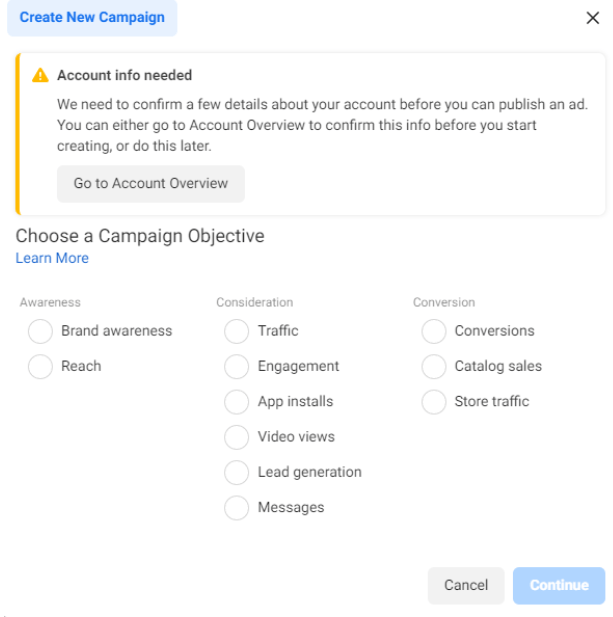
Facebook Campaign Goals that Work for Churches
If you want your journey into Facebook Ads for churches to be a successful one, you'll need to understand the characteristics and advantages of each goal objective type. Knowing these details will help you choose the right one for each of your campaigns.
Reach (Awareness Stage)
If you want your ad to be seen by as many people as possible, this one is for you. When choosing this option, you’ll want to focus primarily on people who have not heard about your church or its charities, fundraisers or events. You can exclude your website visitors from this campaign through the audience exclusions. This way you won’t waste money on advertising to people who already know about your church.
For this campaign goal option, you’ll pay little for the impressions you generate. Facebook will also keep the frequency low, which means it will restrict instances where the same person sees your ad multiple times. Because the same individual rarely sees the ad more than a couple of times, more people end up seeing your ad using this option.
Although this campaign objective is a great way to get in front of a large amount of people, it requires follow up. Getting in front of a bunch of people doesn’t do your church a lot of good if they immediately forget about your advertisement.
Big brands will create reach campaigns with the intention of creating a traffic campaign later. They do this because they want the people that have just been introduced to their brand to move a little further down the prospect journey.
Once these people click on a certain page, they can use the Facebook retargeting pixel (we’ll go into detail about that later on) to retarget the users with additional ads to bring them even further on the prospect’s journey.
Because a reach campaign requires other, more targeted campaigns to bring individuals through the prospect’s journey, they can often be too expensive for most churches. For this reason, we don’t recommend this goal type when using Facebook Ads for churches.
For some larger congregations that have experience with Facebook Ads, it might be worth testing out. But if you're first starting out and your budget is limited, you should try other goal types first.
Brand Awareness (Awareness Stage)
Brand awareness is similar to reach. It also tries to get your church in front of a lot of people who might not have heard of you. The major difference is that it is a little more selective than the reach campaign. It will show your ads to the same people more often than a reach campaign would.
The brand awareness objective uses an internal algorithm to distribute your ads to the people most likely to remember your church within the next two days.
Like the reach campaign, the brand awareness campaign requires follow up. This means you’ll have to spend additional budget on campaigns like link click or traffic campaigns to move individuals through the prospect journey. Larger churches with big teams of volunteers or staff might have the expertise to pull this strategy off, but most churches won’t initially.
If you choose this Facebook Ads for churches strategy, be aware you’ll likely incur higher costs for poorer results. After all, there’s a reason this type of strategy is often used by large organizations. The bigger the organization is, the larger the budget they have to spend on multiple campaigns and the teams and tools to optimize them.
Engagement (Consideration Stage)
The engagement goal objective allows Facebook to focus on generating as many engagements as it can within your budget. The types of Facebook engagements include event responses, page likes and post interactions (comments, shares, reactions).
Churches will choose this type of objective because they want to expand the reach of their organic Facebook posts. When people engage with your content on Facebook for the first time, they will begin to see more organic content from your church as they scroll their newsfeeds.
This is one of the reasons why this goal objective is so effective when it comes to Facebook Ads for churches. After all, churches want people within the community looking at their latest updates. This way you can let them know when new events are happening and persuade them to join your congregation in worship or in support of a particular mission.
Another reason why the engagement option works well for most churches is retargeting. Facebook allows churches to target anyone who has engaged with their posts. This means you can easily stay in front of these people, allowing your church to continue to move individuals through the prospect’s journey.
Traffic (Consideration Stage)
The link click objective is popular when it comes to Facebook Ads for churches. The reason is this objective allows churches to maximize the number of people who visit their website. If an individual doesn’t convert on their first visit, you can easily set up a retargeting campaign to prompt them to convert at a later date.
Lead Generation (Consideration Stage)
If you’re looking to capture contact information for prospects on Facebook, Facebook lead ads work great. The reason is that individuals don’t even leave Facebook when completing a form. And, Facebook will even auto-populate information for the user when they click into your form from the call-to-action button.
This is an amazing objective when it comes to Facebook Ads for churches. However, it is a little more complicated than other options to set up. You have to create a form and undergo a series of steps. You will also need to create some sort of offer or illustrate a benefit for the Facebook user to fill out the form. This could be something as simple as a sign-up for your church’s monthly newsletter or a timeslot to speak with your pastor about faith and spiritual matters.
This campaign objective type does require more work on your part, but it is worth it. It has worked well for many Facebook advertisers, because it allows them to contact prospects outside of Facebook. You can use the email and phone email you gain from these campaigns to craft messages that bring individuals closer to your desired action.
Messages (Consideration Stage)
Facebook Messenger is a great tool to connect with friends and family, and thanks to the messages objective, you can use it to connect with those within and outside of your church community. With message ads you can create a series of premade questions, responses and offers to entice people to fulfill your objective.
For example, let’s say your church wants to grow membership by offering spiritual appointments with your pastor. You could ask Facebook users a question such as, “Do you feel a little lost or alone?”
You can then choose preselected responses like “yes” or “no.”
If the user selects “yes,” you could include an automatic response such as, “You’re not alone. We’ve all felt that way before. The key is to reach out. Vanco Valley Church doesn’t want anyone to feel the pain of loneliness. That’s why Pastor Paul devotes hours each week to discuss how to build a personal relationship with Christ. Your relationship with God is personal to you, which is why Pastor Paul will meet with you one-on-one to help you embark upon your journey with the Lord. Don’t feel that sunken feeling of loneliness again. Gain the support you need. Schedule your appointment today.”
And if the user selects “no,” you could craft a similar message about preparing for the day we need the love of Christ most. Then, give the same one-on-one appointment offer.
With the message objective, there are plenty of permutations you can build. The key is to experiment to see what works best. You can even try advertising on WhatsApp and Instagram Direct, which are both Facebook properties.
Another use for the message objective and the ads that go with them is retargeting. With this objective type, you can retarget Facebook users that have engaged with you in a number of ways.
When it comes to Facebook Ads for churches, the message objective is one of the better options you can experiment with. It allows your church to add more of a human element to its ads. The key is to make sure your messages have plenty of heart in them and don't sound robotic.
Conversions (Conversion Stage)
When using Facebook Ads for churches, the conversion objective stands out as one of the most effective. The reason is that you can easily see the direct impact your Facebook ads have on your church’s campaigns. Whether you’re looking for volunteers, new members, donations or other outcomes, you can see the number of conversions your conversion campaign generated.
And, because Facebook’s artificial intelligence finds ways to maximize the number of conversions you get within your budget, it’s easier to get more of them.
Although this campaign objective is definitely one you should use, many churches shy away from it simply because it is a little trickier to use than most other campaign goal objectives. In order to effectively use the conversion goal objective, you need, at a minimum, three things:
1) A Facebook Tracking Pixel on Your Website - Facebook needs to collect data on your website users to understand who converts. They then use this data to make data-based guesses on who is most likely to convert. This allows your church to reduce the amount it spends on advertisements while increasing conversions.
There are a number of ways to set up the Facebook tracking pixel. The easiest way is to use a built-in integration with your website. Wix, Squarespace and WordPress are among the most popular website builders in the U.S. If your church uses one of these three for your website, you’re in luck. We’ve included the instructions for setting up the Facebook pixel on each below. Simply click on the link and follow the instructions for a simple and fast setup.
You can also use Google Tag Manager to simplify the creation of your tracking. Google Tag Manager is free and works on most websites. It has several advantages as it serves as one bucket for all your website’s tracking codes. This helps your website load faster as the more code you place on your website, the more time it takes to load.
Google puts a strong emphasis on page speed to determine its organic rankings, which is why limiting the tracking codes on the website helps your church.
Google Tag Manager is harder to use than a built-in Facebook integration with your website creator, but it’s easy enough for an amateur to use. Because it is so widely used, Google Tag Manager (GTM) also has integrations with most popular website creation software to simplify the setup.
To set up the Facebook tracking pixel within Google Tag Manager, you’ll need to first create a GTM account. Follow these video instructions to set it up. The video shows you how to set up a Google Analytics account as well, which is useful for tracking your website’s data.
Then, once you set up your Google Tag Manager account and your container that holds all your tracking codes, you can place the code for your Facebook tracking pixel within the GTM container. Follow these instructions to complete the process.
2) Facebook Conversion Events - Facebook conversion events are small snippets of code you add to your thank-you pages. The code fires each time a user reaches the thank-you page. This is how Facebook knows who converted and from what ad and campaign. It then takes the aggregate data to help optimize the account.
If you’re looking to set up Facebook conversion events, here’s how.
3) Conversions Every Week – When selecting the conversion goal objective, Facebook’s artificial intelligence serves your ads to those most likely to make a conversion. It determines who is most likely to make a conversion based off your past conversion data. That’s why this objective won’t work if you only get about a dozen or less conversions a month. The reason is Facebook doesn’t have enough history for its robots to figure out the characteristics of those most likely to convert.
You should avoid this goal objective until you can generate enough conversion data for Facebook’s robots to make great assumptions.
Additional Goal Objective Types
There are additional objectives you could use when it comes to Facebook Ads for churches, but we decided to leave them out. The three we didn’t cover are rarely used for churches. You might be able to find success with the goal objective types that weren’t covered, but it’s best to start with the seven we listed first. Most of them are easier to manage for beginners and they have a better track record.
Facebook Ads for Churches Best Practices
Our team at Vanco has managed Facebook ad accounts for a long time now. We learned how to manage accounts the hard way, by experience, and although there’s no substitute for practice, you can enjoy a stronger start to your Facebook ad journey by following a few best practices. Here are some of the ones we wish we knew more about right away.
Retargeting
Retargeting is one of the main reasons why so many ministries use Facebook ads for churches. It offers an effective way to connect with people who might have come across your church in the past but didn’t take any action. Because these people know who your church is and a little about you, it takes less effort to move them through the prospect’s journey.
You can retarget these people with custom audiences that allow you to build a list of prospects who have engaged with your church. These engagements can include websites, comments to your posts on Facebook, responses on Facebook Messenger and more. You can even upload a list of emails, which Facebook will match with its user account information.
Facebook calls these lists of prospects "custom audiences," and building one to target within your campaign is easy. Simply follow the steps within this video. The video describes how to set up a custom audience for retargeting users that visited an organization’s website. If you want to create an audience based off another input, many of the steps are similar.
Monitor Frequency
Have you ever had the same ad shadow your every turn as you browse your Facebook feed? It gets a little awkward and uncomfortable. Keep your church’s Facebook ads from annoying prospects. Watch the frequency of your ads to make sure your audience doesn’t burn out on seeing them.
A little bit of monitoring will keep your church from making a poor impression on prospects, and it will save you money. It will also make your church stand out as a respectful advertiser.
To monitor frequency, find the frequency column within your reports. In most cases, the column is within your data table by default. If you can’t find the column, you’ll need to go to customize columns, type in “frequency” in the search bar and select the checkbox next to frequency.
If the average frequency is over seven, you’ll definitely want to pause your ads. Depending on what your campaign’s objective is and your campaign audience, you’ll likely want to shoot for an even lower frequency. The key is to determine how many impressions per user is too much, then complete one or more of the following actions once that threshold has been reached...
A) Pause your ads.
B) Create new ads to replace the old ads.
C) Reduce your daily or lifetime budget.
This best practice of Facebook Ads for churches might seem obvious to some ministries, but you would be surprised how many advertisers miss it. When these advertisers forget to check frequency, their ads often become counterproductive to their purpose of drawing in prospects.
Geo Location
Unless you’re a mega church with an online following or are running a nationwide charity, you’ll want to spend extra time on your location options when setting up your church’s Facebook ads.
In most cases, Facebook will default to your country as the targeted area. Leaving this as is will lead to a lot of waste for churches trying to expand their reach within a specific area.
Adjusting the targeted location is easy. Facebook lets you do radius targeting, which targets the radius around a certain point. For example, let’s say our church, Vanco Valley Church, is located in Minneapolis. Because many people in the metropolitan area around Minneapolis are willing to drive to the city for an event or service, you would set the targeted radius around the city to 25 miles. 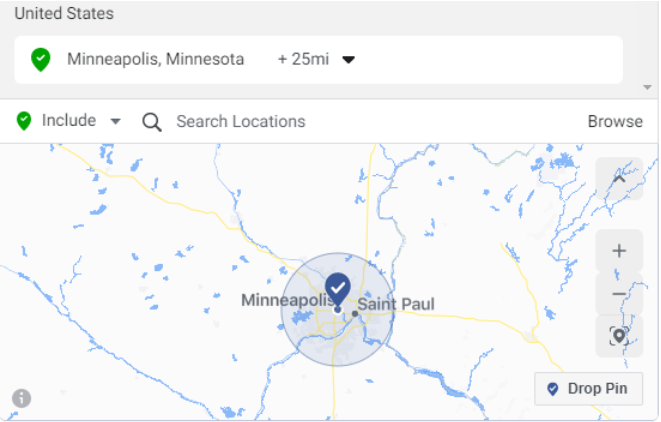
Once you set your targeted area, you’ll want to adjust one more location setting. Adjusting this setting will limit waste and lead to better outcomes for your campaign.
Above the locations, you’ll see a dropdown box like this.
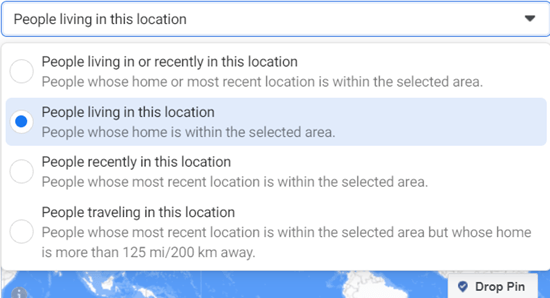
If you’re a local church, you’ll want to select the “People living in this location” option. This will ensure you're connecting with the people in your community. The other options in the dropdown will likely lead to wasted spend, as many would include people who are unable to join your church events due to distance.
How to Expand and Narrow Audiences
One of the keys to success when it comes to Facebook Ads for churches is understanding how to expand and narrow audiences. With Facebook Ads Manager, you can add targeting characteristics such as interests to either expand your audience or narrow it down.
This is important because you’ll often want to focus on people who match multiple characteristics. For example, let’s say you’re trying to promote a concert for your church’s worship team. Perhaps you have an amazing guitar player, vocalist, drummer and a master on the keyboard. You could promote a concert for them to perform and draw people to your church.
It is possible to target people within your area that listen to “Contemporary Christian Music,” but how many of these people would be interested in going to a concert?
Just because someone in your area likes the type of music played at your concert doesn’t mean they’ll want to attend. They might prefer to listen on the radio or have too many commitments to make a concert.
That’s where the “Narrow Audience” button comes in.
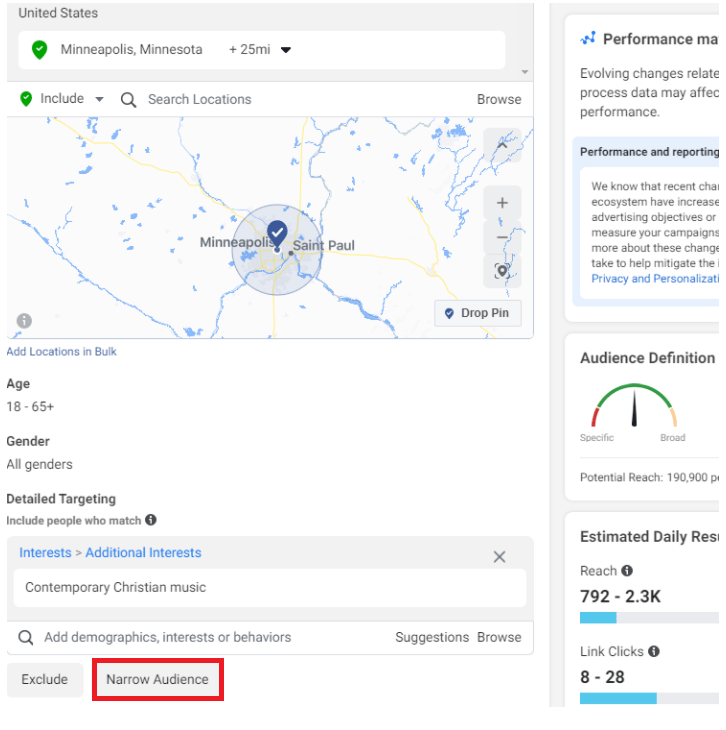
If you ignore the “Narrow Audience” button and add an interest or behavior or demographic, the meter on the right-hand side will turn its dial to the right as the audience expands.
If you select the “Narrow Audience” button and add the interest of “concerts,” you’ll notice the dial moves further to the left and becomes more specific. Narrowing the audience this way increases the likelihood an ad recipient will attend the concert.
Someone who likes contemporary Christian music and has an interest in concerts has a higher likelihood of attending your concert.
With the narrow audience feature, you can build several different audiences and test them against each other.
Once you find an audience combination that works for one campaign, take note of it. Chances are you can use this audience again for future Facebook ad campaigns.
Video
Facebook video posts have the highest engagement rates on the platform. People stop scrolling on their feeds to look at videos five times longer than non-video content (AdExpresso). This means you will have fewer instances of people scrolling past your ad without noticing it.
The success of video is why so many ministries turn to it when they decide to use Facebook Ads for churches.
Creating a Facebook video ad might seem hard, but it isn’t as hard as it used to be. Because so many churches have had to adapt to include online services, they’ve built the skills they need to create videos.
Ask for the help of your media team or volunteers, and remember, you don’t need to create a Hollywood-quality video. Plenty of advertisers on Facebook, even those that aren’t churches, use simple videos taken with their cell phones for their campaigns.
If you’re looking to create these types of ads, this short video guide shows you how and details some of the best practices and options you should consider using.
Connect Your Instagram Page to Your Account
As we mentioned earlier, Facebook owns Instagram, which is why Facebook Ads Manager allows your church to advertise on both Facebook and Instagram.
You might be surprised by the varying performances the platforms deliver for different campaigns. That’s why it’s good to always test the two separately.
When creating campaigns, consider building one for each platform. You can use a lot of the same ad content and the targeting for each to save time. The separate campaigns will make it easier to see what ads work better on each platform.
Test
With any church marketing, you’ll need to make your best guess as to what will work. You can make this guess using the information you have on hand, such as your past experience, surveys of existing members and even website data.
Ultimately, even if you spend countless hours digging into trends, you won’t know what works and what doesn’t until you try it. For this reason, you’ll need to rely on testing when it comes to Facebook Ads for churches. When testing your hypothesis, try a simple split test.
A split test involves creating two campaigns or ads that are near matches to each other save for one attribute. For example, let’s say you want to see what audience responds more favorably to the offer of a spiritual consult with your pastor. You can create two different campaigns with the same ads but use different audiences for each.
Or, let’s say you want to see what ad image works best to get your website users interested in a church fundraiser. You can create two different ads within your campaign that have the same text and headline but use a different image.
Testing one element at a time allows you to determine what characteristic of your campaign or ad made a difference.
Testing on Facebook is also easy. Facebook built a feature that allows you to split test a variety of different attributes. Be sure to use this feature to zero in on what is most effective for your church.
Test Small and Fail Fast
Facebook Ads for churches won’t always work. Despite all your planning, your best guesses will fail, and that’s OK as long as you...
A) Test Small.Churches advertising on Facebook can test small by setting deadlines for the campaign to prove results. Oftentimes, churches will build campaigns and forget them. As time goes by, Facebook will slowly chew away at their ad budgets with little to show for it.
For this reason, it’s a good idea to set a lifetime budget for your new Facebook campaigns. If the new campaign proves its worth, you can switch to daily budget for easier management.
B) Fail Fast.Facebook Ads work for churches as long as the advertisers fail quickly. This means you want to learn from your mistakes and note them. Keep a spreadsheet of your tests and list out what works and what doesn’t. This way, you won’t waste money on ideas that you’ve tried in the past.
This is doubly important for churches who often rely on volunteers to manage their Facebook account. These notes allow each new volunteer to pick up where the previous one left off.
Facebook Ad Examples for Churches
Now that we've gone through the technical aspects of Facebook Ads for churches, you'll need some content ideas to build your advertisements.
Check out these 11 Facebook ad examples you can emulate with your marketing strategy. Each of these examples are from ministries using the platform to promote their missions, and they are great illustrations of how to use Facebook Ads for churches.
1. NewSpring Church
One of the first churches that exhibited a great example of Facebook Ads for churches is NewSpring church. NewSpring Church uses Facebook Ads to promote a blog post. The way they did so is by selecting a blog post that Facebook is not emphasizing as much and pairing it with a solid image of their logo.
In the advertisement, NewSpring has an invitation not only to read the blog post but also to attend their services. They tie the subject of their blog post into the sermons that the pastor gave the past week. In the comments, church leaders and parishioners comment to drive engagement and boost the visibility of the ad.
By using comments and likes on their post, the church can boost the ad's position on viewers' Facebook feeds. Plus, their appealing visuals and relatable language make their advertisement easy to connect with. They're learning how to pair visually appealing content with relevant messages to create stunning advertising campaigns.
2. North Point Community Church
Another church that is succeeding with its Facebook advertisements is North Point Community Church. This church focuses its advertising efforts on quotes.
What's unique about NPCC's strategy is that instead of opting for standard Bible passages or well-known Christian quotes, they choose to use unique quotes from their pastor's latest sermons in their ads. Then, they run their ads right before or after Sunday to entice the congregation to come to a service and hear what the sermon's focus of the week will be.
On top of that, NPCC pairs these quotes with visually appealing photos. They use photos that focus on people rather than on vague religious concepts. By doing so, they show what it's truly like to worship in their parish - both visually and verbally.
They also use photos are taken in their parish. This adds a personal touch to their advertising strategy and helps keep their current congregation members engaged with their advertisements as well as potential church visitors.
3. Willow Creek Community Church
Willow Creek Community Church does a great job of making its church stand out from the crowd in its strategic marketing plan. At the same time, they make it clear what church visitors can expect to see when attending a Sunday service.
This church focuses its promotion on unique and highly creative video advertisements. They focus on a piece of scripture and combine it with consistent hashtags to help their church stand out and show up in community members' newsfeeds.
They also help put their church at the forefront of searches using hashtags repeated across various social media posts. This is a great strategy for reaching people even if their advertisement isn't displaying on their newsfeed organically.
Finally, one of the best aspects of this church's Facebook ads is that they use minimal design. Their minimalist approach helps keep the focus on the goal of the post and reminds visitors of the goal of the advertisement.
4. Church of the Highlands
If you're looking for church growth tools that work, Church of the Highlands is a great place to look for inspiration. This church leverages a solid Facebook advertising strategy that focuses on showing what serving with their parish is really like.
Church of the Highlands uses posts that feature volunteers and parishioners serving their community. This imagery is paired with a simple title, a clear date, and easy-to-understand details. Since nothing gets lost in the weeds with this ad, it's easy to follow.
On top of that, this church asks for prayer requests in each of their Facebook ads. Doing so is not only a great way for you to connect with parishioners and prompt engagement, but it's also a great way to help others spiritually - even people that you don't know!
Finally, Church of the Highlands makes sure to link all their Facebook page posts to services at their new campus. Not only is this exciting, but it's a great way to encourage parishioners and community members to attend their new church location and to help the new church plant grow.
5. Fellowship Baptist Panama City
Fellowship Baptist Church, located in Panama City, offers us a great example of Facebook advertising in their Trunk or Treat ads. This series of ads use a colorful, holiday-themed text graphic as a Facebook Event Ad.
While the ads themselves are ordinary, they could encourage 500 new people to show up. For a church of 100 people, this is quite an accomplishment and shows the power of simple text advertising for reaching out to new community members.
One reason that this ad series was so successful was that the parish was willing to put a fair chunk of money into its advertising strategy. With a higher budget, they were able to run the ad for more time and pay for more clicks to their website.
When churches focus their Facebook advertising efforts on a few key events, they have a larger budget at their disposal. The result is that even though they're running fewer ads throughout the year, the ads they do run are more impactful and enable the church to welcome more members at those specific times of the year.
6. The Rock Church Australia
Another successful church Facebook Ads example can be seen in The Rock Church in Australia. Their advertising strategy focuses on simple images paired with entertaining text descriptions peppered with emojis.
The emojis, hashtags, and links throughout the advertisement make it a more appealing and entertaining ad for viewers. They're more likely to click on these ads because they seem relevant and modern.
Plus, the linking and hashtag strategies that the ads employ makes it more likely for these ads to appear when viewers are perusing Facebook. The result is that more eyes are on the advertisement, leading to a higher turnout for church events or Sunday services.
7. Grace Central Coast
Grace Central Coast is a multi-campus church based out of California that uses Facebook advertising to help them set up several new church plants. They keep their ads simple by using Facebook Event Ads that focus on easy-to-read text and simple graphics.
While the ad seems to be unremarkable at first glance, the reality is that its simplicity makes it easy to understand. It gets straight to the point, keeping viewers focused on what they could get out of a visit to this parish.
One of the takeaways from Grace Central Coast is that Facebook Ads don't need to be overly exotic to draw parishioners in. Sometimes simple advertisements make for the best advertisements.
8. Bayside Community Church
Bayside Community Church offers us a great example of how you can capture the interest of viewers with their Facebook advertising strategy. Bayside uses testimonials from real parishioners and features them in their Facebook posts.
One of the benefits of using testimonials is that they tell a story. Story brand advertising is a way to get people to engage with your organization. The advertising approach tells a story about who you are or what you're doing. The reason this works is that it's interesting.
On top of that, testimonials are extremely inspiring. They make things personal and help your ads feel more "real" and less "businessy." This is extremely important for churches that are looking to truly connect with their parish and draw in new church members and visitors.
9. Central Church
Just about every church out there hosts at least one or two large events a year. Maybe it's the annual Christmas pageant, or, perhaps it's a vacation bible school during the summer months.
At Central Church, they capitalize on these events by using their Facebook ads to countdown to their major annual events. Each day, they post a new advertisement with sneak peeks of what attendees can expect at the event, along with a simple number graphic.
The result is that the ads build hype and start to get people excited about attending the church's events. Plus, the sneak previews get parishioners inspired and make them more likely to attend the event to learn more about what they'll see there.
10. Elevation Church
Lots of churches have turned to livestream services following the COVID-19 pandemic. Whether you're using YouTube, a paid provider or Facebook to livestream services or events, livestreaming is a great way to reach community members who may not be physically able to attend a church service. And, they're a way to unify church members even when it's not possible to meet in person.
Elevation Church does a great job of using Facebook Ads to promote their livestream events. The church not only shares its livestream link every Sunday but also runs ads promoting the recording of the livestream.
This tactic is great for getting people to engage with your church and become a member - even if they're not physically able to attend. And, it's a unique alternative to traditional Facebook Ads that only focus on in-person events.
11. Eastside Christian Church
Eastside Christian Church is another great example for you to mimic as you create your own ads. This parish uses Facebook advertising to promote small groups.
Where most churches spend time focusing their advertising efforts on Sunday services and large events, this church primarily seeks to draw people into small group settings. This can help some of their more intimate outreach efforts to be more successful.
On top of that, in intimate settings, it can be easier for some people to open up and feel comfortable. This might make them more likely to be long-term members of the church as opposed to one-off visitors. Try promoting your Bible studies and other gatherings in your Facebook ads.
The Cost-Effective & Easy Way to Market Your Church
What if your church could get $120,000 in free online advertising each year?
Or, advertise locally without spending much at all?
We'll show you how you can get a free six-figure advertising budget and other cost-effective methods to promote your church and its ministries. All you need to do to get these high-impact church marketing and advertising secrets is download our free, comprehensive guide.




